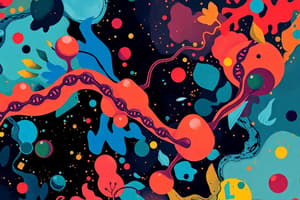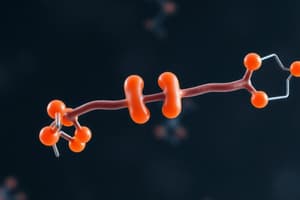Podcast
Questions and Answers
Which enzyme is responsible for the decarboxylation step in the Pyruvate Dehydrogenase Complex?
Which enzyme is responsible for the decarboxylation step in the Pyruvate Dehydrogenase Complex?
- Coenzyme A
- Pyruvate dehydrogenase (E1) (correct)
- Dihydrolipoyl transacetylase (E2)
- Dihydrolipoyl dehydrogenase (E3)
What is the role of NAD+ in the reaction catalyzed by the Pyruvate Dehydrogenase Complex?
What is the role of NAD+ in the reaction catalyzed by the Pyruvate Dehydrogenase Complex?
- It assists in the transfer of electrons during the oxidation of the acetyl group. (correct)
- It serves as an allosteric inhibitor of E2.
- It acts as a coenzyme for the synthesis of acetyl-CoA.
- It acts as a substrate for the reduction of FAD.
Which of the following correctly describes the regulation of the Pyruvate Dehydrogenase Complex?
Which of the following correctly describes the regulation of the Pyruvate Dehydrogenase Complex?
- ADP is an allosteric inhibitor that enhances glycolysis.
- Acetyl-CoA activates the PDC via covalent modification.
- NADH and acetyl-CoA are both allosteric inhibitors. (correct)
- Phosphorylation of E1 by PDK increases the activity of PDC.
Which step of the Pyruvate Dehydrogenase Complex involves transferring the acetyl group to coenzyme A?
Which step of the Pyruvate Dehydrogenase Complex involves transferring the acetyl group to coenzyme A?
What is the primary product of the Pyruvate Dehydrogenase Complex after the completion of all five steps?
What is the primary product of the Pyruvate Dehydrogenase Complex after the completion of all five steps?
Which allosteric molecule activates the Pyruvate Dehydrogenase Complex?
Which allosteric molecule activates the Pyruvate Dehydrogenase Complex?
What is the effect of dephosphorylation of the E1 component of the PDC?
What is the effect of dephosphorylation of the E1 component of the PDC?
What essential function does the Pyruvate Dehydrogenase Complex serve in aerobic respiration?
What essential function does the Pyruvate Dehydrogenase Complex serve in aerobic respiration?
Flashcards
Pyruvate Dehydrogenase Complex (PDC)
Pyruvate Dehydrogenase Complex (PDC)
A multi-enzyme complex in the mitochondrial matrix that converts pyruvate into acetyl-CoA, linking glycolysis to the citric acid cycle.
What does PDC catalyze?
What does PDC catalyze?
PDC catalyzes the oxidative decarboxylation of pyruvate, a process that removes carbon dioxide from pyruvate and produces acetyl-CoA.
What are the components of PDC?
What are the components of PDC?
PDC is composed of three enzymes: pyruvate dehydrogenase (E1), dihydrolipoyl transacetylase (E2), and dihydrolipoyl dehydrogenase (E3).
Allosteric Regulation of PDC
Allosteric Regulation of PDC
Signup and view all the flashcards
Covalent Modification of PDC
Covalent Modification of PDC
Signup and view all the flashcards
Importance of PDC
Importance of PDC
Signup and view all the flashcards
PDC and Energy Production
PDC and Energy Production
Signup and view all the flashcards
PDC Overall Significance
PDC Overall Significance
Signup and view all the flashcards
Study Notes
Pyruvate Dehydrogenase Complex (PDC) Overview
- The Pyruvate Dehydrogenase Complex (PDC) is a large multi-enzyme complex located in the mitochondrial matrix.
- It catalyzes the oxidative decarboxylation of pyruvate, a crucial step in aerobic respiration.
- This reaction links glycolysis to the citric acid cycle (Krebs cycle).
PDC Reaction Steps
- The PDC is composed of three enzymes:
- Pyruvate dehydrogenase (E1)
- Dihydrolipoyl transacetylase (E2)
- Dihydrolipoyl dehydrogenase (E3)
- The reaction proceeds in five steps:
- Decarboxylation: Pyruvate is decarboxylated, releasing CO2. This step is catalyzed by E1, and requires thiamine pyrophosphate (TPP).
- Oxidation: The resulting two-carbon fragment is oxidized, forming an acetyl group. This involves the transfer of hydrogens and electrons to lipoamide, a prosthetic group on E2. The oxidation also requires NAD+.
- Acetyl Group Transfer: The acetyl group is transferred from lipoamide to coenzyme A (CoA), forming acetyl-CoA. This step is catalyzed by E2.
- Reduction: The reduced lipoamide on E2 is reoxidized by FAD, a prosthetic group on E3.
- Reduction of FAD to FADH2: The reduced FAD then transfers electrons to NAD+, resulting in NADH and regenerating the oxidized form of FAD.
PDC Regulation
- The PDC is a key control point in cellular metabolism.
- Its activity is regulated by allosteric effectors and covalent modification, which maintain appropriate metabolic flux.
Allosteric Regulation
- Acetyl-CoA and NADH act as allosteric inhibitors, reducing the activity of the PDC.
- ADP is an allosteric activator, increasing PDC activity, reflecting the energy status of the cell.
Covalent Modification
- Phosphorylation of the E1 component of the PDC inhibits its activity.
- Phosphorylation is catalyzed by pyruvate dehydrogenase kinase (PDK).
- Dephosphorylation of E1 by pyruvate dehydrogenase phosphatase (PDP) activates the PDC.
Importance of PDC
- The PDC is essential for generating acetyl-CoA, which enters the citric acid cycle to further oxidize the acetyl group and generate ATP.
- This process is crucial for producing energy in the aerobic respiration, supplying reducing equivalents (NADH) to the electron transport chain.
- The overall reaction links glycolysis to the citric acid cycle, allowing the organism to use glucose to generate energy.
- Deficiency in individual PDC enzymes can manifest as a syndrome in which accumulation of pyruvate leads to a buildup of toxic substances.
Prosthetic Groups and Cofactors
- Thiamine pyrophosphate (TPP), lipoamide, FAD, and NAD+ are key coenzymes and prosthetic groups essential for the PDC's function.
- These coenzymes and prosthetic groups assist in the transfer of electrons and groups during the reaction.
Studying That Suits You
Use AI to generate personalized quizzes and flashcards to suit your learning preferences.
Description
This quiz provides an overview of the Pyruvate Dehydrogenase Complex (PDC), detailing its role in aerobic respiration and the steps involved in the catalytic process. Understand the important enzymes and the mechanism linking glycolysis to the citric acid cycle. Test your knowledge on this critical metabolic pathway.




